
The Tatars, formerly also spelt Tartars, is an umbrella term for different Turkic ethnic groups bearing the name "Tatar" across Eastern Europe and Asia. Initially, the ethnonym Tatar possibly referred to the Tatar confederation. That confederation was eventually incorporated into the Mongol Empire when Genghis Khan conquered the various steppe tribes. Historically, the term Tatars was applied to anyone originating from the vast Northern and Central Asian landmass then known as Tartary, a term which was also conflated with the Mongol Empire itself. More recently, however, the term has come to refer more narrowly to related ethnic groups who refer to themselves as Tatars or who speak languages that are commonly referred to as Tatar.

Ivan IV Vasilyevich, commonly known as Ivan the Terrible, was Grand Prince of Moscow and all Russia from 1533, and Tsar of all Russia from 1547 until his death in 1584. He was the first Russian monarch to be crowned as tsar.

The Golden Horde, self-designated as Ulug Ulus was originally a Mongol and later Turkicized khanate established in the 13th century and originating as the northwestern sector of the Mongol Empire. With the division of the Mongol Empire after 1259, it became a functionally separate khanate. It is also known as the Kipchak Khanate or as the Ulus of Jochi, and it replaced the earlier, less organized Cuman–Kipchak confederation.
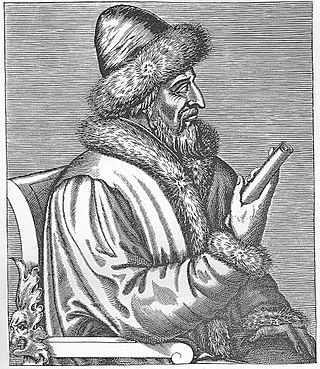
Vasili III Ivanovich was Grand Prince of Moscow and all Russia from 1505 until his death in 1533. He was the son of Ivan III and Sophia Paleologue and was christened with the name Gavriil (Гавриил). Following on the ambitions of his predecessor Ivan, Vasili conquered Pskov, Ryazan and Smolensk as well as strengthening Russian influence in Kazan and to the Volga region. Several nobles were either exiled, sentenced or executed for criticizing his policies.
Safa Giray was three times khan of Kazan. He was the nephew of the previous Kazan Khan Sahib Giray and brother of Moxammat Giray.
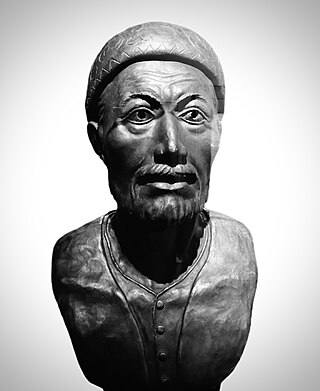
Möxämmät-Ämin xan (Möxämmät Ämin, Möxämmädämin, Russian: Мухаммед-Амин, Muhammed-Amin / Emin, Magmed-Amin, Магмед-Аминь, etc. was three times a pro-Russian khan of Kazan. During his first reign, he actively supported the policies of the Grand Duke of Moscow and proved himself to be "a true friend of Russia". He was also known as a poet; excerpts from his works have survived to this day. After ascending the throne for the second time, he changed his political views, emphasizing the independence of the khans. Muhammed-Amin "enjoyed the love and respect of the people"; Kazan flourished under him. Muhammed-Amin’s remains discovered in Soviet era were buried in the Kazan Kremlin in 2016.

Devlet I Giray ruled as Crimean Khan during a long and eventful period marked by significant historical events. These events included the fall of Kazan to Russia in 1552, the fall of the Astrakhan Khanate to Russia in 1556, and the burning of Moscow by the Crimean Tatars in 1571. Another notable event during Devlet's reign was the defeat of the Crimeans near Moscow in 1572. However, Cossack raids into the Crimea were also common during his reign.
Ibrahim khan was the Khan of Kazan from 1467. He was the son of Mäxmüd. He was crowned after Xälil's death and was married to Nur Sultan. In 1467–1469 and 1478, he participated in wars against Muscovy. After concluding a treaty with Ivan III, all Russian prisoners of war held by the Khanate were released. He supported a policy of non-intervention into Muscovy's politics.

Munkh Tumur or Möngke Temür was a son of Toqoqan Khan and Köchu Khatun of Oirat, daughter of Toralchi Küregen and granddaughter of Qutuqa Beki, and the grandson of Batu Khan. He was a khan of the Golden Horde, a division of the Mongol Empire in 1266–1280.
The Russo-Crimean Wars were fought between the forces of the Tsardom of Russia and the Crimean Khanate during the 16th century over the region around the Volga River.
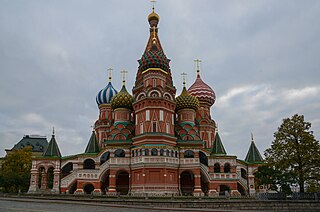
The Russo-Kazan Wars was a series of wars fought between the Grand Principality of Moscow and the Khanate of Kazan from 1437, until Kazan was finally conquered by the Tsardom of Russia under Ivan the Terrible in 1552.
Vasily Danilovich Kholmsky was a Russian knyaz, Boyar and Muscovite voyevoda. He was the son of Prince Daniil Kholmsky and the son-in-law of Grand Prince Ivan III, having married his daughter Feodosiya Ivanovna. Kholmsky was a member of the princely house Kholmsky, and descended from the rulers of the Principality of Tver.
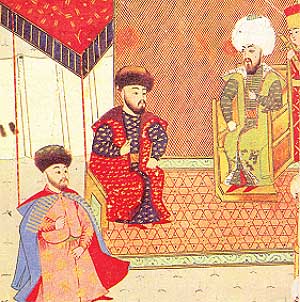
Mehmed I Giray was khan of the Crimean Khanate. He was preceded by his father Meñli I Giray and followed by his son Ğazı I Giray (1523–1524). He gained control of the steppe nomads, put his brother on the throne of Kazan and was killed after taking Astrakhan.
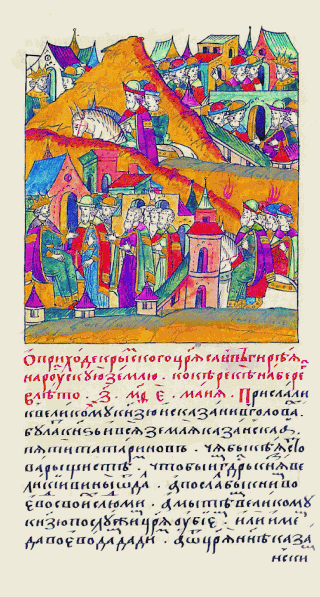
Sahib I Giray (1501–1551) was Khan of Kazan for three years and Khan of Crimea for nineteen years. His father was the Crimean Khan Meñli I Giray. Sahib was placed on the throne of Kazan by his ambitious brother Mehmed of Crimea and driven out of Kazan by the Russians. He became Khan of Crimea with Ottoman support and was expelled by the Turks for disobedience. During his reign Crimean troops fought for the Turks and also fought in the North Caucasus. In 1532-1584, during the long reigns of Sahib I Giray, Devlet I Giray and Mehmed II Giray, Crimea was at the height of its power.

The steppe and forest-steppe of Ukraine and southern Russia is good agricultural land, but it was traditionally held by pastoral nomads. Any state that could drive off the nomads and fill the land with tax-paying peasants would expand its power enormously. During the period 1500–1800, this region was taken under Russian control.

Ulugh Muhammad was a medieval Tatar statesman, Gengisid, Khan of the Golden Horde, ruler of Crimea (1437), and the founder of the Khanate of Kazan, which he ruled from 1438–1445. He was the son of the oglan Ichkile Hassan and the cousin of Tokhtamysh. He received the nickname "Ulugh", meaning older or large, in contrast to another Muhammed who was called "Kichi", meaning younger or small.

Nizhny Novgorod was founded by Prince Yuri II of Vladimir in 4 February 1221. Citizens organized an army to liberate Moscow from the Poles in 1611, led by Kuzma Minin and Prince Dmitry Pozharsky. During the Russian Empire, in 1817 Nizhny Novgorod became the country's main trading city. In 1896, the city hosted the largest All-Russia exhibition. In the Soviet era, Nizhny Novgorod was renamed Gorky, in honor of the writer Maxim Gorky. Then it was the industrial center of the Soviet Union. During the World War II, the city sent to the front a huge amount of military equipment and ammunition. Therefore, the German air force bombed the city for 3 years. After the dissolution of the Soviet Union, the city was renamed back to Nizhny Novgorod. In Russia, the city became a political center and the capital of the Volga Federal District. Now the city is the center of information technology and develops tourism.
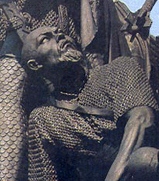
The Great Troubles, also known as the Golden Horde Dynastic War, was a war of succession in the Golden Horde from 1359 to 1381.













